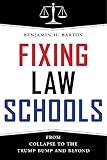Fixing Law Schools : From Collapse to the Trump Bump and Beyond / Benjamin H. Barton.
Material type: Computer filePublisher: New York, NY : New York University Press, [2019]Copyright date: ©2019Description: 1 online resourceContent type:
Computer filePublisher: New York, NY : New York University Press, [2019]Copyright date: ©2019Description: 1 online resourceContent type: - 9781479895090
- Law schools -- United States -- History -- 21st century
- Law -- Study and teaching -- United States
- Law -- Vocational guidance -- United States
- LAW / General
- ABA
- American Bar Association
- Charlotte School of Law
- DOE
- Department of Education
- Harvard Law School
- Trump Bump
- University of Cincinnati
- Washington and Lee University
- Whittier Law School
- accreditation
- antitrust
- apprenticeship
- disaccreditation
- employment
- federal student loan
- lawyering
- legal services
- lost decade
- output regulation
- proprietary
- regulating
- student debt
- tuition hikes
- tuition
- underemployment
- 340.071173 23
- KF272 .B378 2019
- online - DeGruyter
| Item type | Current library | Call number | URL | Status | Notes | Barcode | |
|---|---|---|---|---|---|---|---|
 eBook
eBook
|
Biblioteca "Angelicum" Pont. Univ. S.Tommaso d'Aquino Nuvola online | online - DeGruyter (Browse shelf(Opens below)) | Online access | Not for loan (Accesso limitato) | Accesso per gli utenti autorizzati / Access for authorized users | (dgr)9781479895090 |
restricted access online access with authorization star
http://purl.org/coar/access_right/c_16ec
An urgent plea for much needed reforms to legal education The period from 2008 to 2018 was a lost decade for American law schools. Employment results were terrible. Applications and enrollment cratered. Revenue dropped precipitously and several law schools closed. Almost all law schools shrank in terms of students, faculty, and staff. A handful of schools even closed. Despite these dismal results, law school tuition outran inflation and student indebtedness exploded, creating a truly toxic brew of higher costs for worse results.The election of Donald Trump in 2016 and the subsequent role of hero-lawyers in the “resistance” has made law school relevant again and applications have increased. However, despite the strong early returns, we still have no idea whether law schools are out of the woods or not. If the Trump Bump is temporary or does not result in steady enrollment increases, more schools will close. But if it does last, we face another danger. We tend to hope that crises bring about a process of creative destruction, where a downturn causes some businesses to fail and other businesses to adapt. And some of the reforms needed at law schools are obvious: tuition fees need to come down, teaching practices need to change, there should be greater regulations on law schools that fail to deliver on employment and bar passage. Ironically, the opposite has happened for law schools: they suffered a harrowing, near-death experience and the survivors look like they’re going to exhale gratefully and then go back to doing exactly what led them into the crisis in the first place. The urgency of this book is to convince law school stakeholders (faculty, students, applicants, graduates, and regulators) not to just return to business as usual if the Trump Bump proves to be permanent. We have come too far, through too much, to just shrug our shoulders and move on.
Mode of access: Internet via World Wide Web.
In English.
Description based on online resource; title from PDF title page (publisher's Web site, viewed 26. Mrz 2024)


